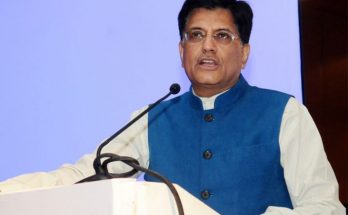 After the anointment of Gujarat Chief Minister Narendra Modi as the Bharatiya Janata Party’s official prime ministerial candidate for the coming general elections, two distinct possibilities are on the political horizon.
After the anointment of Gujarat Chief Minister Narendra Modi as the Bharatiya Janata Party’s official prime ministerial candidate for the coming general elections, two distinct possibilities are on the political horizon.
Either a National Democratic Alliance (NDA) government headed by NarendraModi or a United Progressive Alliance government led either by Rahul Gandhi as prime minister or a person of his choice heading the government, is most likely to assume power after the elections. The possibility of a single-party government, appears remote, despite Modi’s popularity among the urbanised middle class and today’s aspiring youth.
It seems highly unlikely that the BJP, on its strength alone, will be able to form a government at the centre. Even a third front or a fourth front coalition government, albeit an outside chance, would require support from one of the two national parties to assume power.
In any case, Narendra Modi or Rahul Gandhi are bound to ‘own’ the policies of the next government, for better or for worse.
The forthcoming general election is a contest between two distinctive political philosophies, rather two contrasting views of society and polity. Though there are some common features, the differences stand out in stark relief.
Both Modi and Gandhi are not going to be different in their economic policies as both would like to work for the generation of national wealth. Their policy framework would try to create a conducive environment for economic growth as both their respective parties are committed for a higher growth of gross domestic product (GDP). They are conscious of the fact that without a higher economic growth rate, the country cannot meet the challenges of poverty, health, education and housing which are the crying needs of the majority of country’s population.
While their economic policies may have a common objective and some common features, they would not be identical in their emphasis and priorities. Their social policies, however, would be a study in contrast.
Ongoing political discourse points out that while the Congress is stressing upon pluralism and inclusiveness, the RSS-led BJP is highlighting ‘Hindutva’ (Modi’s stress on issues of development have taken a back seat). The BJP is promising a strong leadership with clear vision and is attacking the Congress for a weak leadership and corrupt governance.
In case Modi becomes the prime minister riding a ‘Hinduatva’ wave then his policy options would also be constrained and his social policy framework would be seriously handicapped. It would be very difficult for Modi to have a policy which benefits religious minorities or other socially deprives sections of society as any such policy would not find favour with the RSS.
Let us scrutinise the challenger Modi’s policies first. It’s not yet known what Modi’s policies would be at the national level, as he has not yet spoken about them in his interaction with the media or in his public discourses but one can take a guess by examining the ‘Gujarat model of development’ during his 12 years of administration.
Modi has been at the helm in Gujarat since 2001 when he had replaced Keshubhai Patel as the chief minister of the coastal state that had already been doing pretty well on economic front. The GDP growth in Gujarat has been relatively good in comparison to the all-India level in the past two decades. Other states that have grown at almost similar rates in the last decade are Maharashtra, Haryana and Tamil Nadu.
At the same time, it must be said here that the high growth rate in Gujarat has been more balanced. It has been the result of enhanced performance of almost all sectors, particularly the agricultural sector.
In precise terms, Modi’s polices have been pro-big business and industry friendly. What has provided impetus to his economic policies in Gujarat has been his style of administration which is characterised by a focused approach and reduction of bureaucratic hurdles in decision making. Modi’s administration is highly centralised as power has been concentrated in Chief Minister’s Office. It is well known that none of his ministerial colleagues have either the power or guts to take a policy decision and this style of administration has impressed the captains of Indian industry and business.
Gujarat has attracted investments by speedy clearances and plenty of concessions. Industry and business leaders have found Gujarat a good investment destination as the state administration has gone out of way to facilitate their entry by offering them land and water on concessional terms. While in the last couple of years land acquisition in other states has been a big stumbling block, Gujarat has been able to provide even fertile agricultural land for setting up industrial ventures. Tata’s Nano project is a classing example of this. Within a short span, Tata industrial group could shift from West Bengal to Gujarat, and the first car rolled out of the factory.
But a careful scrutiny of the performance figures in term of employment, wages, consumption, poverty, inequality and outcomes in health and education reveals that this broad based growth has led to some worrisome results. The biggest casualty of the much projected ‘Gujarat Model’ has been the employment. The aggregate employment in Gujarat has remained stagnant.
According to National Sample Survey Organisation data, the employment in Gujarat for the period 1993-94 to 2004-05 was 2.69 percentages per annum, whereas for 2004-05 to 2009-10 it came down to almost zero.
Even in terms human development index (HDI), Gujarat has the highest incidence of malnutrition among Muslims, the SC/ST and women. Out of the total 17 states, Gujarat was ranked 13 in term of hunger index, much below poorer states such as Orissa, Uttar Pradesh, West Bengal and Assam.
In short, policies under Modi’s leadership would be industry and business friendly but in his hurry to ensure rapid economic growth, poor and marginalised sections of society would not get enough attention as is evident in Gujarat.
If Modi decides to follow the same set of policies at the national level after coming to power, he would face a serious dilemma: what’s good for Gujarat may not be good for other states. This would require an approach of flexibility and a spirit of adjustment. Whether Modi would be able to adapt and mould himself to new situation, in which he alone would not be the decision maker, seems to be a difficult in the background of his known style of working.
A coalition government has its own limitations as allies weigh in with their own versions of wisdom, and as a result, often prove to stunt or digress the growth process. For last 12 years Modi has been leading a single party government in Gujarat and is known to have a very low level of tolerance to opposition. He, thus, has very little experience of managing the contradictions of a coalition government. Unlike the former Prime Minister Atal Bihari Vajpayee, who remained in opposition for over four decades before coming to power, Modi seriously lacks the skills to lead a coalition government.
Presiding over Gujarat without much opposition, he succeeded in providing a better administration which has ensured relatively better policy implementation. But whether, he would be able to run the country of over 1.2 billion like he did for last 12 years appears to be a difficult if not an impossible task. Any set of policies, however good, are of no consequence if they can’t be implemented.
In first hundred days of coming to power, Modi would find it difficult to take any major policy initiative as his energies would be devoted to coalition management but in case he were to head a single party government then he would have an opportunity to concentrate power in the PMO so that business friendly economic policies could be put in place.
If a Congress-led UPA (United Progressive Alliance) coalition government comes back to power, its policies would be more or less a continuation of the present course which has been followed by Prime Minister Manmohan Singh government. Gandhi has been consistently saying that he supports the UPA policies which seek to empower the poor, less privileged, socially backward and marginalised sections of society by providing them food, education, good health and a habitation. This alone, in Gandhi’s understanding, can release the energies which are needed to take the country forward.
Gandhi’s focus would be on providing better governance by improving delivery systems and removing administrative deficiencies. Emphasis would be on e-governance which is one of the important tools against corruption in day-to –day life of an ordinary citizen. At the same time, Gandhi would take the demographic dividend into account while tweaking the UPA policies for the growing young population.
Gandhi’s policies are rooted in national consensus and thus would not be difficult to implement even in a coalition government while Modi’s policies require a one party government to deliver optimum results.
(Dr Satish Misra is a veteran political commentator. The views expressed in this column are personal reflections of the author).
Author Profile
Latest entries
 DiplomacyMarch 31, 2021Heart of Asia: Jaishankar calls for ‘double peace’ in Afghanistan
DiplomacyMarch 31, 2021Heart of Asia: Jaishankar calls for ‘double peace’ in Afghanistan India and the WorldSeptember 11, 2020India, China forge 5-point formula to defuse border crisis
India and the WorldSeptember 11, 2020India, China forge 5-point formula to defuse border crisis India and the WorldJanuary 8, 2019India-Nordic Connect: New Horizons
India and the WorldJanuary 8, 2019India-Nordic Connect: New Horizons NewsMay 15, 2018On Iran and Trump, India has landed between a rock and a hard place
NewsMay 15, 2018On Iran and Trump, India has landed between a rock and a hard place







